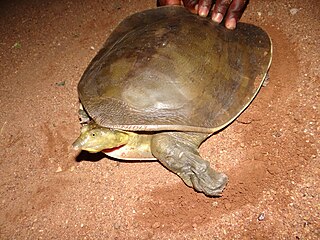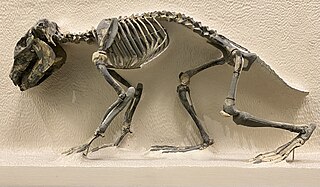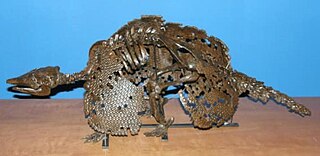Related Research Articles

The Mymarommatidae, sometimes referred to as false fairy wasps, are a very small family of microscopic parasitic wasps. Only about half of the known species are living taxa, but they are found worldwide.

Cyclanorbis is a genus of softshell turtles in the family Trionychidae. The genus is endemic to Africa.

Cycloderma is a genus of softshell turtles in the subfamily Cyclanorbinae of the family Trionychidae. The genus is endemic to Africa.

Hegetotheriidae is an extinct family of notoungulate mammals known from the Oligocene through the Pliocene of South America.
Ganorhynchus is an extinct genus of prehistoric lungfish from the Devonian period. Fossils were found in Mansfield, Pennsylvania.
Brevidorsum is an extinct genus of dissorophoidean euskelian temnospondyl within the family Dissorophidae.
Branchierpeton is an extinct genus of dissorophoidean euskelian temnospondyl within the family Micromelerpetontidae native to Africa.
Batrachosuchoides is an extinct genus of prehistoric amphibian from the Early Triassic of Russia. It was found in the Baskunchakskaia Series and the Lestanshorskaya Svita.
Batrachosaurus is an extinct genus of prehistoric brachyopoid amphibian that lived in Germany during the Middle Triassic (Ladinian). The genus was named by Joseph Fitzinger in 1837 and the type species, B. jaegeri, was named three years later in 1840. It may have been the same animal as Mastodonsaurus.
Gosfordia is an extinct genus of prehistoric lungfish known from the Triassic of Australia.

Megapleuron is an extinct genus of prehistoric sarcopterygian or lobe-finned fish that lived during the Asselian age of the Cisuralian epoch in what is now Burgundy, France.
Pillararhynchus is an extinct genus of prehistoric sarcopterygians or lobe-finned fish.

Pachyarmatherium is a genus of extinct large armadillo-like cingulates found in North and South America from the Pliocene and Pleistocene epochs, related to the extant armadillos and the extinct pampatheres and glyptodonts. It was present from 4.9 Mya to 11,000 years ago, existing for approximately 4.889 million years.

Chelonoidis is a genus of turtles in the tortoise family erected by Leopold Fitzinger in 1835. They are found in South America and the Galápagos Islands, and formerly had a wide distribution in the West Indies.

The Trionychinae are a subfamily of turtles in the family Trionychidae.

Alienochelys is an extinct genus of marine turtle known from Maastrichian-aged Cretaceous phosphates in Morocco. With a skull measuring 41.5 centimetres (1.36 ft) long, it would have been a very large turtle. It was first described as a member of the family Dermochelyidae, meaning that it is a relative of the modern leatherback turtle, though a 2018 study identifies it as a sister taxon of Ocepechelon belonging to the family Protostegidae, indicating that it may have been closer to the extinct Archelon. Unlike other sea turtles, Alienochelys' the jaws being adapted for a powerful crushing pattern well adapted for a durophagous lifestyle, as well as its unusual cranial characteristics.
Micromomyidae (Micromomids) is a family of extinct plesiadapiform mammals that include some of the earliest known primates. The family includes five genera that lived from the Paleocene epoch into the early Eocene epoch.

Hippohyini was an extinct tribe of Suinae which existed in Asia during the Pliocene.

Hyotheriinae was a subfamily of even-toed ungulates that existed during the Miocene and Pliocene in Europe, Asia, and Africa.
Microcnemus is an extinct genus of lizard-like early archosauromorph reptiles from the Protorosauridae. Members of the genus lived during the Early Triassic period in Russia. Once believed to have been an ancestor to lizards, Microcnemus is now known to be one of the oldest members of the lineage that would eventually lead to archosaurs such as crocodilians and dinosaurs. The type species, M. efremovi, was named in 1940 by the German palaeontologist Friedrich von Huene.
References
- ↑ "Fossilworks: Anatomites". fossilworks.org. Retrieved 17 December 2021.
- ↑ "Fossilworks: Juvavites (Anatomites) konnincki". fossilworks.org. Retrieved 17 December 2021.
- ↑ "Chiara Guaiumi's research works | University of Padova, Padova (UNIPD) and other places". ResearchGate. Retrieved 2019-03-10.